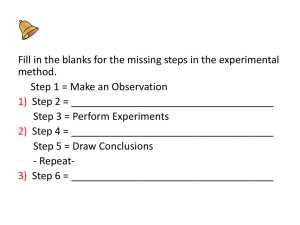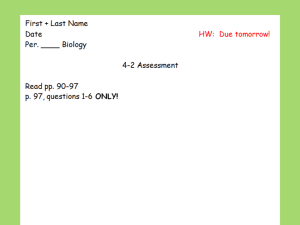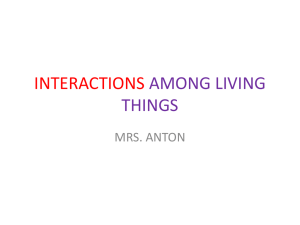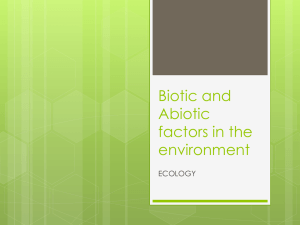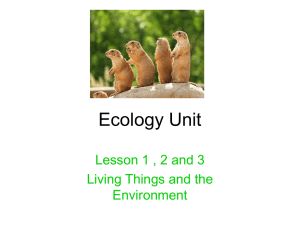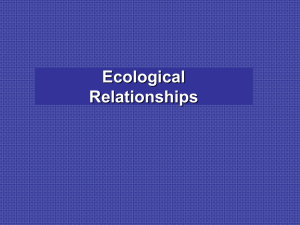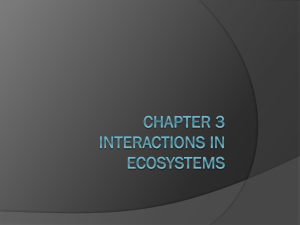ppt
advertisement
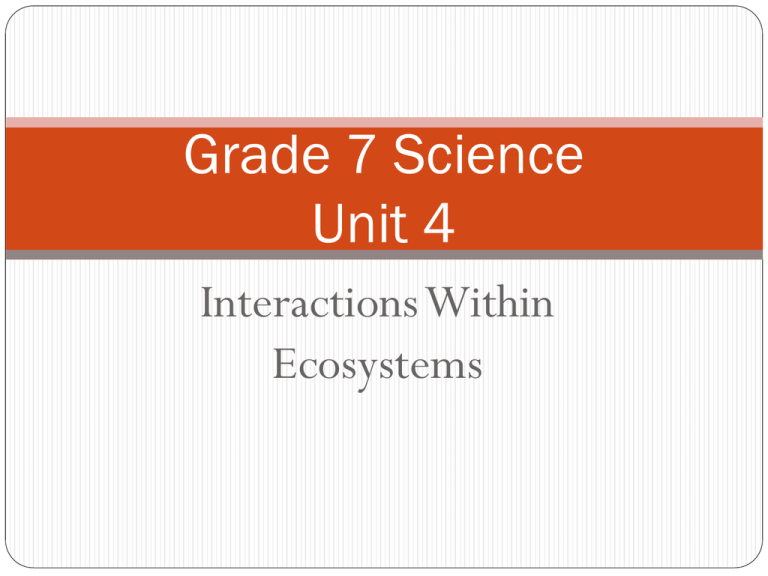
Grade 7 Science Unit 4 Interactions Within Ecosystems What is Ecology? The study of the relationships between living organisms and their environment. Scientists who study these relationships are called ecologists. Ecosystem: What is it? What is an Ecosystem? The interactions between living and non- living things in a particular environment. E.g. A rotting log is an example of an ecosystem. The organisms living in and on the log and the soil, temperature, and other non-living features around the log are interacting. Ecosystems... Can be described by the types of organisms and the conditions found there. include abiotic (non-living) and biotic (living) things. Can be large or small. Let’s go Outside… School yard activity Local Area: Living Things Local Conditions The Abiotic Environment The non-living parts of the environment. The upper and lower limits in which an organism can survive is called the organism’s range of tolerance. Abiotic Factors: Examples include... 1. Intensity of sunlight 2. Temperature 3. Soil 4. Air and wind 5. Water The Biotic Environment The living parts of the environment. Includes MANY species of organisms ( living things). Species: a group of organisms that can reproduce to produce similar, fertile organisms. What do living things need for survival? With a partner, generate a list of the things that all living things must have for survival. The Needs of Living Things All living things from spiders, to sunflowers, to humans need… 1)Food 2)Water 3)Habitat 4)Air (gas exchange) Living things are always interacting with each other and with the non-living things in their environment. Adaptation Adaptation: is an inherited characteristic that helps an organism survive and reproduce in its environment. E.g. A duck has webbed feet so it can swim well E.g. Many birds have hollow bones so they can fly easily. Continued… There are however many characteristics that help animals survive in their environment that are learned. E.g. Humans learn to look both ways before crossing the street. These however, are not adaptations. Can you remember what an Ecosystem is? An ecosystem is the interactions between living and non-living things in a particular environment. What is a Biome? Complete the Biome Worksheet Levels of Organization ecosystem community population individual The Roles of Organisms in an Ecosystem Niche: The role of an organism in its ecosystem. To determine an organism’s niche, you must look at what it eats, where it lives, and how it interacts with other organisms in its ecosystem. Interactions Between Living Things in an Ecosystem Symbiosis: Occurs when two species live closely together in a relationship that lasts over time. Can you think of any examples?? 3 Types of Symbiosis Mutualism: Each partner benefits from the relationship! e.g. The remora fish uses suckers on its head to attach itself to a shark. It then eats the bacteria living on the shark’s skin. Other examples?? Continued… Parasitism: One partner benefits from the relationship and the other is harmed. Which is which?? Parasite or host?? Examples: tapeworm, mosquito, leech Types of Ecosystems... Ocean Forest Pond Arctic Use your textbook and the internet to complete the following chart on each type of ecosystem. Ecosystem Flora Fauna Abiotic plants animals Cond. 1. Oceans 2. Forest 3. Pond 4. Arctic Field Trip to the Schoolyard Habitat –vs- Niche Habitat: the organism’s address; where does it live? Ex. A moose’s habitat is the boreal forest. Niche: the organism’s job; what role does the organism play in its environment. It includes: where it lives how it obtains food how it affects its environment Ex. A moose lives in the boreal forest, it is a herbivore (plant eater), it provides a home for parasites and it provides food for coyotes. Interactions in the Environment Biotic - abiotic Abiotic - abiotic Biotic - biotic



